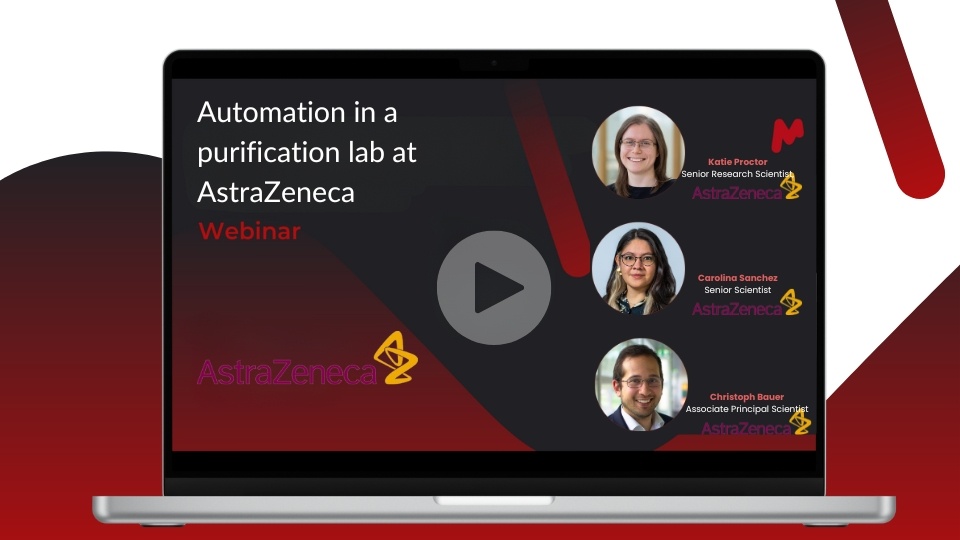The lab of the future is already here … It’s time to ACT
The demand for, and adoption of lab automated systems has been constantly increasing over the past few years, the market for which is anticipated to grow by 7.6%, up to $9.21 billion, by 2029*. The benefits of such automations are undeniable: higher throughput and accuracy, and lower human effort and risk of error. It is, however, impossible to take full advantage of these benefits without simultaneous automation and integration of data processing and analysis.
That’s why for many labs it is already time to ACT!!
Automate…
Analytical data generated by automated lab processes is big and rich to the point no human effort alone can handle it. Advanced data processing and management systems are key to reaping the full benefits of automation in the chemistry lab. Chemistry data usually comes from different sources: raw data from instruments, AI algorithms’ output data, sample information from third-party software (DoE software, other example, spreadsheets, etc.), molecular structures from editors, etc., all of which needs to be correctly and efficiently matched and analyzed in its globality to extract appropriate insights and knowledge.
To successfully achieve the above, flexibility is paramount. Rigid end-to-end systems tend to complicate this process. However, with the features we have implemented in our automation engine Mnova Gears to handle, detect, and match all input data, almost any scenario is feasible. Whether data is coming from an NMR spectrometer, an LC/GC-MS system, or a UV spectrometer, and independently of the vendor or the format, it will be captured and processed as required. The samples can be named as wished, sample information can be provided in txt, csv, or sdf files, and acquisition can occur in batch or real time… every single aspect of the analysis can be finely tuned and adapted to each lab’s unique processes.
At the other end of the analysis process, result recompilation and reporting are also crucial but time-consuming tasks to which automation could clearly bring invaluable benefits. Unorganized data is difficult to explore and becomes less of an asset and more of a burden that holds scientists back. Automating report generation and result visualization is a game changer! It enables scientists to make stop/go decisions comfortably and confidently by enabling rapid consideration the results. All of this is possible with our automation engine: its default configuration produces insightful, visual results dashboards and reports in PDF, Mnova, and other formats and, using templates and scripting, the possibilities available to the end user are practically infinite… Finally, all the raw and processed data, as well as the generated reports are archived and can be databased seamlessly, so that the scientist does not have to go through this process manually.
Connect…
In medium to large companies, chemical data is often collected from various facilities, departments, and/or sites, and often ends up being extremely and dangerously siloed. It is no secret that a fluid, uninterrupted data flow between the different systems and groups in an organization saves time, effort, and reduces the costs derived from repeating unnecessary experiments or analyses.
Connecting data analysis systems and forcing a continuous sync on data is sometimes difficult, expensive, and requires extensive professional services and support. We had all of this in mind when developing our no-code/low-code environment, Mgears. Mgears can connect to other players in the lab and industry ecosystem like LIMS, ELNs, and datahubs or data lakes, etc., via its API, scripting capabilities, and its open architecture. It can retrieve chemical and analytical data from these different systems, visualize, reprocess, and analyze it, then push it back to update and enrich your company’s records. Data is therefore consolidated and consistent across all systems at all times.
And let’s talk about data formats, because every instrument and every system generates and accepts data in a specific format. This is why having vendor-independent software is crucial to achieving successful integration. As mentioned above, with Mnova, all types of analytical data (NMR, LC/GC-MS, UV, Raman, etc.) are accepted, which makes Mnova the perfect, interoperable interface to replace the many other vendor- and instrument-specific software suites found across the lab.
…and Thrive
Automating and integrating data processes in the overall lab/IT ecosystem is a vital project to any company trying to undergo digital transformation. By freeing up scientists from long-winded, boring, error-prone, manual tasks and consolidating data flows and management systems, labs can successfully transition to the digital world and guarantee a sustainable environment where the huge amounts of data that are produced at a rapid rate are processed and available in a timely manner.
Data siloes will slowly break down; communication will hugely improve.
Employees will be empowered, productivity will increase.
Human error, product waste, etc., will be reduced, costs of inefficiencies will be cut down.
And the business will thrive!
*Data Bridge Market Research, Global Total Lab Automation Market – Industry Trends and Forecast to 2029, June 2022: https://www.databridgemarketresearch.com/reports/global-total-lab-automation-market
This article is the first one of a four-part series. Check it out!
Back to Series



